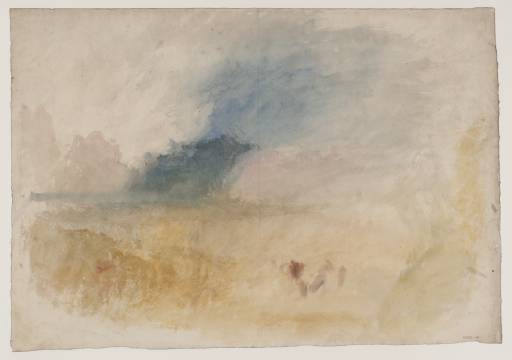Joseph Mallord William Turner A Stormy Coast, Possibly near Criccieth Castle, Bamburgh Castle or Dunwich c.1828-37
Joseph Mallord William Turner,
A Stormy Coast, Possibly near Criccieth Castle, Bamburgh Castle or Dunwich
c.1828-37
Joseph Mallord William Turner 1775–1851
A Stormy Coast, Possibly near Criccieth Castle, Bamburgh Castle or Dunwich c.1828–37
D25170
Turner Bequest CCLXIII 48
Turner Bequest CCLXIII 48
Watercolour and chalk on white wove paper, 355 x 510 mm
Watermark ‘Ruse & Turners | 1828’
Blind-stamped with Turner Bequest monogram towards bottom right
Stamped in black ‘CCLXIII – 48’ bottom right
Watermark ‘Ruse & Turners | 1828’
Blind-stamped with Turner Bequest monogram towards bottom right
Stamped in black ‘CCLXIII – 48’ bottom right
Accepted by the nation as part of the Turner Bequest 1856
Exhibition history
2011
William Turner. Maler der Elemente / Turner and the Elements, Bucerius Kunst Forum, Hamburg, June–September 2011, Muzeum Narodowe, Krakow, October–January 2012, Turner Contemporary, Margate, January–May 2012 (38, reproduced in colour, as ‘Storm, with Lightning, on Coast’. c.1820–30).
References
1909
A.J. Finberg, A Complete Inventory of the Drawings of the Turner Bequest, London 1909, vol.II, p.818, CCLXIII 48, as ‘Storm, with lightning, on coast’. c.1820–30.
1997
Eric Shanes, Turner’s Watercolour Explorations 1810–1842, exhibition catalogue, Tate Gallery, London 1997, pp.93, 94, 95, 101, 104: (Appendix I under ‘Bamburgh Castle’, with query, p.94 under ‘Criccieth Castle’, as ‘But possibly a preparatory study for Bamburgh Castle ... or for Dunwich in the East Coast series’), (p.95 under ‘East Coast of England Series’, with query), (p.95 under ‘England and Wales Series’, as ‘?Study for Crickieth Castle, North Wales’. c.1836), (p.101 under ‘Sea Sketches and Studies’), (p.104 Appendix II, as ‘Study: Crickieth Castle, North Wales/Bamburgh Castle/Dunwich’).
The ‘lightning’ noted by Finberg in his title ‘Storm, with lightning, on coast’ appears to be indicated by a roughly vertical stroke of chalk, barely legible now, against the pale area of cloud or sky towards the top left. This is one of four colour studies linked by Eric Shanes with varying degrees of certainty to the watercolour Criccieth Castle of about 1835 showing the castle at Criccieth, near Porthmadog, Gwynedd (British Museum, London),1 engraved in 1837 for the Picturesque Views in England and Wales (Tate impressions: T04610, T06126).2 The other studies are Tate D25161, D25174 and D25293 (Turner Bequest CCLXIII 39, 52, 171).
Shanes has also suggested a link3 to the large watercolour of Bamborough Castle (Northumberland), exhibited in 1837 (private collection),4 for which there are other Bamburgh colour studies at Tate (D25456, D25457, D25506, D36321; Turner Bequest CCLXIII 333, 334, 382, CCCLXV 30). Another possibility he offers is in relation to the rather smaller watercolour on blue paper, Dunwich (Suffolk), of about 1827 (Manchester Art Gallery),5 which was engraved for the Picturesque Views on the East Coast of England (unpublished; Tate impression: T04613).6
All these finished designs feature distant buildings (of which there are no signs here) on promontories above broad beaches with figures, which are perhaps suggested here by the dark strokes towards the bottom right. As any identification of the present subject is likely to remain speculative, it is dated here to between 1828 and 1837, taking its watermark and the finished Bamburgh watercolour as parameters.
See also the Introductions to the present subsection of tentatively identified but unrealised subjects and the overall England and Wales ‘colour beginnings’ grouping to which this work has been assigned.
Technical notes:
There is a vertical fold at the centre of the sheet, where the washes have gathered a little.
There is a vertical fold at the centre of the sheet, where the washes have gathered a little.
Eric Shanes notes that the paper is the ‘same’ as for the colour studies Tate D25165, D25167–D25169, D25171, D25184 and D25208 (Turner Bequest CCLXIII 43, 45–47, 49, 62, 86).1 The ‘Ruse & Turners’ watermark was current from 1805 to the 1840s, representing various permutations of partners (Richard Turner and Mr Letts by 1828) producing paper at Upper Tovil Mill, Maidstone, Kent.2
Verso:
Inscribed in pencil ‘AB 92 P | O’ top left, upside down; stamped in black with Turner Bequest monogram above ‘CCLXIII – 48’ bottom right; inscribed in pencil ‘CCLXIII 48’ bottom right.
Inscribed in pencil ‘AB 92 P | O’ top left, upside down; stamped in black with Turner Bequest monogram above ‘CCLXIII – 48’ bottom right; inscribed in pencil ‘CCLXIII 48’ bottom right.
The ‘AB’ number corresponds with the endorsement on one of the parcels of works sorted by John Ruskin during his survey of the Turner Bequest, in this case classified by him as ‘Colour effects. Valueless’.1
There are five faint pencil landscapes, not recorded by Finberg. They are separated by framing lines in a continuous column down the right-hand quarter of the sheet, with a further scene beside the lowest of the five, running across to the bottom centre. With groves of trees, an arch, a multi-arched bridge and distant buildings, they are not readily recognisable as studies for particular compositions, perhaps being spontaneous variations on classical motifs in the manner of Claude Lorrain (1604/5–1682) so admired and so often adopted by Turner.2
Matthew Imms
March 2013
How to cite
Matthew Imms, ‘A Stormy Coast, Possibly near Criccieth Castle, Bamburgh Castle or Dunwich c.1828–37 by Joseph Mallord William Turner’, catalogue entry, March 2013, in David Blayney Brown (ed.), J.M.W. Turner: Sketchbooks, Drawings and Watercolours, Tate Research Publication, December 2013, https://www

